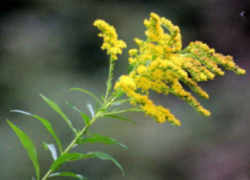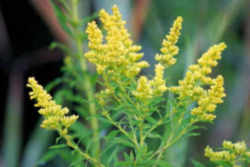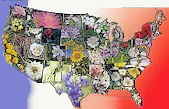Nebraska State Flower
Goldenrod

(Solidago serotina)
Adopted on April 4, 1895.
The goldenrod, (Soldiago gigantea,) was declared Nebraska state flower in 1895. The flower, spelled "Golden Rod" in the legislation and referred to as ("Solidago Serotina") is commonly called giant goldenrod (Solidago gigantea) today.
A concurrent resolution giving the state a floral emblem was introduced by Rep. L. P. Judd of Boone County. Numerous species of goldenrod grow throughout the state.
The measure was supported by University botanist Dr. Charles Bessey. Undoubtedly, the article written by Miss Brockman, who was the daughter of Rep. John M. Brockman of Stella, had some part in seeing the resolution signed into law by then-governor Silas A. Holcomb. The article written by Ida Brockman, daughter of Rep. John M. Brockman of Stella, said:
"There is probably not a nook or corner of the state where one or more of the numerous species of goldenrod are not found. It is a native, and only a true native should be our representative. It has a long season, and nothing could better represent the hardy endurance of Nebraska's pioneers. "
The resolution was signed into law by then-governor Silas A. Holcomb on April 4, 1985.
Three states have adopted goldenrod as state flowers: Kentucky, Nebraska, and South Carolina.
Nebraska State Flower: Goldenrod

The goldenrod is an erect, coarse-looking perennial herb that is usually about two or three feet tall. The small flower heads, which are almost always yellow but sometimes have cream-colored or white rays, are grouped into either elongated or flattish clusters. The flowers appear from July through October.
Identification of the Goldenrod
- Plant Type: This is a Native herbaceous plant perennial forb. Ususlly erect and often tall.
- Leaves: The leaves are alternate. Most leaves are toothed but a few species have entire leaves.
- Flowers: Blooms July-October. The flowers have numerous parts. They are yellow sometimes white. Blooms first appear in mid summer and continue
into mid fall. The center and rays are yellow. The rays are few, seldom more than ten. Groups of flowers are often clustered on the top edge of branches
near or at the top of the plant.
- Habitat: Various
- Range: Most all of North America
Nebraska House Concurrent Resolution
The goldenrod was proposed as the official floral emblem in a House Concurrent Resolution introduced in 1895 by Nebraska State Representative L. P. Judd of Boone County. With the support of renowned University of Nebraska botanist Dr. Charles Edwin Bessey, the resolution was approved by the Nebraska Legislature and signed by Governor Silas Alexander Holcomb on April 4, 1895. The text of the resolution follows.
Chapter 120
(House Roll No 366.)
A concurrent resolution to designate a floral emblem for the State of Nebraska.
Whereas, the adoption of a state floral emblem by the authority of the legislature would foster a feeling of pride in our state, and stimulate
an interest in the history and traditions of the commonwealth, therefore be it
Resolved, that, the Senate concurring, we, the Legislature of Nebraska hereby declare the flower commonly known as the "Golden Rod"
(Solidago Serotina) to be the floral emblem of the state.
Approved April 4, A.D. 1895.
Taxonomic Hierarchy: Goldenrod
Kingdom: Plantae - Plants
Subkingdom: Tracheobionta - Vascular plants
Superdivision: Spermatophyta - Seed plants
Division: Magnoliophyta - Flowering plants
Class: Magnoliopsida - Dicotyledons
Subclass: Asteridae
Order: Asterales
Family: Asteraceae - Aster family
Genus: Solidago L. - goldenrod
State Floral Emblems








